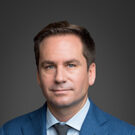The Hartford Financial Services Group’s Liam McGee, who stepped down as president and CEO on July 1 but will remain executive chairman until next year’s shareholder meeting, spoke about the company’s transformation at the second quarter earnings conference call Thursday.
“The last few weeks have been welcome as I have been able to focus on my health, and I do appreciate the many expressions that I received from so many of you. I am very pleased to report that I am feeling much better and stronger,” said McGee, who has undergone a medical procedure.
McGee, a former executive at Bank of America who joined The Hartford in 2009, said he’s also had time to reflect on The Hartford’s turnaround and transformation. “The Hartford faced severe challenges when I arrived in 2009, and its future was unclear,” he said. “Today, with a focus on growing profitable businesses, the company’s prospects are bright.”
“While we made many changes over the last five years, I believe three were critical to our success, and we will continue to deliver shareholder value,” McGee said.
First, he said, The Hartford brought clarity to its strategic direction, focusing on businesses where it could compete and win. “We have invested and we will continue to invest in new capabilities for those businesses,” he said. “The result has been sustained margin expansion — with more expected.”
The Hartford has also significantly lowered its risk profile to a more reasonable level, most importantly recently, with the sale of the company’s Japan annuity business. “This will reduce the volatility of The Hartford’s results and will lower our cost of capital going forward,” he said.
Additionally, The Hartford has focused on generating and freeing up capital. “We retained businesses that could create capital and sold other businesses that were capital-consumptive,” McGee said. “We also reduced the size and risk of the Talcott Resolution liability, freeing more capital in the process. As a result, The Hartford now has a very strong balance sheet, with the capital flexibility to take accretive actions to create shareholder value.”
“These three steps — reducing risk, narrowing the strategic focus and generating capital — were key to the transformation and position us well for the future,” McGee said.
McGee said the CEO transition has gone smoothly. “Over the last few years, I have spent a great deal of time on talent development and succession planning with the board of directors, and this thoughtful preparation enabled the board to act quickly and decisively when I decided to step aside as CEO,” he said.
“I must emphasize that I couldn’t be more confident in The Hartford’s future with Chris Swift as CEO, Doug Elliot as president, and Beth Bombara as chief financial officer, as well as the entire executive leadership team,” he said. “Personally, I have fully transitioned to my new role as executive chairman and I look forward to supporting this team.”
CEO Chris Swift added that he and The Hartford’s leadership team are committed to achieving their vision of an exceptional Hartford. “I am excited about the path we are on. We continue to execute the company strategy, profitably growing the P&C, Group Benefits, Mutual Funds businesses, reducing the size and risk of the legacy annuity blocks, and transforming The Hartford into a more effective and efficient organization,” Swift said.
“We have made tremendous progress. Profit margins are expanding in P&C, Group Benefits and Mutual Funds,” he said. “All the businesses are growing the top line, with the exception of Group Benefits, where margins have recovered strongly and the top line has stabilized.”
Commenting on The Hartford’s second quarter results, Swift added that although prior year asbestos and environmental development and elevated storm activity impacted the latest quarterly earnings, the underlying trends in the quarter show a positive momentum.
“I am confident we will continue to expand margins. Our pricing levels are higher than our loss cost trends in the P&C and benefits businesses,” he said.
A&E Reserve Review
The Hartford said the company completes its annual asbestos and environmental studies in the second quarter. Environmental reserve development totaled $27 million, pre-tax, partly because of increased cleanup costs on a few water waste sites. Additionally, the $212 million pre-tax increase in the asbestos reserve primarily arises from a small number of insureds.
“For those insureds, a higher-than-expected frequency and severity of mesothelioma claims drove the reserve increase,” chief financial officer Beth Bombara said. “We continue to proactively pursue legislative and legal remedies to manage these claims costs, including transparency around various asbestos bankruptcy trusts.”
*This story previously appeared in our sister publication Insurance Journal.





















 Palisades Fire Litigation: Suit Alleges LA Utility Mismanaged Water Supply
Palisades Fire Litigation: Suit Alleges LA Utility Mismanaged Water Supply  Are Cars ‘Structures’? Tallying the Damage from the Los Angeles Wildfires
Are Cars ‘Structures’? Tallying the Damage from the Los Angeles Wildfires  2025 Underwriting Profit and ‘Shop-a-Palooza’ Predicted for Auto Insurance
2025 Underwriting Profit and ‘Shop-a-Palooza’ Predicted for Auto Insurance  State Farm Pausing Nonrenewals in Compliance With CDI Notice
State Farm Pausing Nonrenewals in Compliance With CDI Notice 












